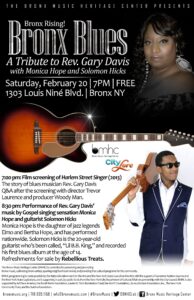
Bronx Blues
A Tribute to Rev. Gary Davis
Feb 20, 2016 @ 7:00pm
7:00 pm: Film Screening of Harlem Street Singer (2013), followed by Q&A with director Trevor Laurence and producer Woody Man
8:30 pm: Performance of Rev. Gary Davis’ music by Gospel singing sensation Monica Hope and guitarist Solomon Hicks
Through high school and college as I followed the Grateful Dead on tour and followed Hot Tuna around New York state, some of my favorite songs from their playlists were from the repertoire of Reverend Gary Davis. “Samson & Delilah,” “Hesitation Blues,” “Death Don’t Have No Mercy” and “Keep Your Lamp Trimmed and Burning” were songs I loved to hear. Imagine my surprise when I come back to the Bronx (I was born here and my parents grew up blocks from the Bronx Music Heritage Center) and found out that Rev. Davis used to live close-by to the BMHC as well. Just as exciting, the musicians I listened to, Bob Weir (Grateful Dead), Jorma Kaukonen (Jefferson Airplane and Hot Tuna), Dave Van Ronk, David Bromberg and others used to travel to this very same neighborhood (and later Da- vis’ home in Queens) to learn his guitar technique—the neighborhood which scares most of the world as the ultimate symbol of urban decay (we are currently three blocks away from the notorious Charlotte Street, visited by many presidents and compared to a World War II bombed-out Dresden). This neighborhood, which used to have an incredible jazz scene along Boston Road and was home to many jazz musicians including NEA Jazz Masters Jimmy Owens and Lou Donaldson and bebop pioneers Elmo Hope and Thelonius Monk. The same neighborhood which was a center for African-American doo-wop in the 1950s. The same neighborhood which produced one of the godfathers of hip hop, Grandmaster Flash. Not surprisingly this neighborhood left its imprint on blues and gospel music as well—a beautiful city indeed!
The story begins in South Carolina on April 30th, 1896 where Gary Davis was born, the son of poor sharecroppers. He lost his sight when he was a few weeks old from ulcers in his eyes due to poor medical care. He had seven siblings who all died be-fore they were thirty years old. Davis started playing harmonica at five years old and soon after his stepfather gave him a banjo and he taught himself how to play that. When he was seven years old his mother bought him his first guitar for $2.50. By the age of fifteen he was good enough to play in local string bands. Davis used a fingerpicking technique that is now known as the Piedmont-style of guitar (from the region in the Appalachian foothills) which is marked by a rhythmic alternating bass pattern played by the thumb, while two other fingers pick a syncopated melody on the treble strings (Zack 19). During the late 1800s and early 1900s it was common to hear blind, itinerant singers on the streets—a consequence of the poor medical care rampart in the poor Black communities. Davis would play on the street and also lead a band along the regional party circuit. It was common for many of the street singers to play at the tobacco warehouses in Durham—where farmers from all over would come to auction their harvest to tobacco companies. As Davis performed he would soon incorporate jazz chords into his arrangements (the 1920s saw the emergence of the Jazz Age). Davis was ordained in 1937 at the Free Will Baptist Connection Church in Washington, North Carolina. After he became an ordained Baptist minister he preferred singing spirituals to the blues. Davis was from South Carolina and both the Carolinas are known as cradles of gospel music. Gary Da- vis, now Reverend Davis would “combine his passion for God and church with his vast knowledge of blues, ragtime, jazz, marching band songs, hill-
billy and minstrel show tunes to create some of the most dynamic guitar-based music ever put to record” (Zack 42).
In 1944 Davis and his wife Annie moved to New York. In April of that year, they moved to an apartment at 405 East 169th Street in the Bronx and lived there until 1960. He was ordained for a second time at the Missionary Baptist Connection church. Davis would often preach at the Union Grove Missionary Baptist Church on Hoe Avenue near Jennings (up the hill from the BMHC), which was built on the site of a former synagogue. This church, unlike more traditional Baptist churches, approved the use of guitars during the services. He also preached at the Second Southern Baptist Church at 1170 Thornton Avenue in the Bronx. After coming to the attention of Alan Lomax in 1950, many young folk musicians began to visit Da- vis at his apartment to learn his fingerpicking style and listen to his songs including, ‘If I Had My Way” (popularly known as “Samson & Delilah”), “Twelve Gates to the City” and “Cocaine Blues.” Soon another Bronxite, Art D’Lugoff, who ran the Village Gate club in Greenwich Village, hired Davis to perform at the club, which he did frequently in the mid-1950s. Davis performed at the Newport Folk Festival in 1959 and this raised his profile even more. Later that year, twenty-year-old Dion DiMucci from the Belmont section of the Bronx (the founder of Dion & the Belmonts, of course) visited Davis and took some lessons. In 1960 the famous folk music magazine, Sing Out! featured Davis on the cover and he was booked at Gerde’s Folk City. Annie and Gary Davis moved to 1482 Brook Avenue (near 168th St.) in the Bronx; and soon after moved once again to 3826 Park Avenue (near 171st St.), which was also visited by many students-turned folk & blues musicians including Stefan Grossman, Rory Block, Tom and Harry Chapin.
Unlike what happened to many blues musicians (see the online feature Led Zeppelin Stole My Blues) Gary Davis as given credit for his songwriting and was able to reap some benefits from it. In 1962, the newly formed Peter, Paul & Mary recorded his “If I Had My Way,” the copyright said “words and music by Gary Davis.” Unfortunately, not all musicians were so courteous—Bronxite Bobby Darin recorded a version of the same song called, “The Sermon of Samson” and writing credit went to Darin and his ar- ranger. Davis started collecting checks and would soon put an end to his street- singing days. In 1964 Annie and Gary purchased a house at 109-42 174th Street in Jamaica, Queens. But he still kept his connections to the Bronx. In 1966 he opened a music store at 3807 Third Avenue in the Bronx. Davis still had visits from many students—Steve Katz co-founder of Blood, Sweat and Tears), Janis Fink (Janis Ian), Woody Mann (who start- ed lessons when he was 12 years old) and Roy Bookbinder. Davis’ influence reached across the continents. Keith Richard of the Rolling Stones, Scottish guitarist Bert Jansch and English guitarist John Ren- bourn, the latter were part of the early English folk-rock scene, were all influenced by Davis’s guitar playing style from songs such as “Cocaine Blues” and “Candyman” (these songs were Davis’ first exposure to the blues from traveling carnival shows he saw as a young man). Bob Weir remembers:
Jorma [Kaukonen, Jefferson Airplane guitarist] was a big fan of his and he helped me look him up in Queens. I made my way out there whenever I was in New York. I only got three or four sessions with him before he passed from this mortal coil (in 1972). He was my main guitar influence, really, and if you listen to his stuff you‘ll see that he took it all from piano, too—all of his parts are stride piano playing adapted to guitar. It’s amazing stuff. He had a Bachian sense of music, which transcended any common notion of a bluesman (Alan Paul interview with Bob Weir 2001, www.alanpaulinchina.com/2-11/01/from-archives-bob-weir.html ).
On May 5th 1972, Davis passed away and his funeral was held at the Union Grove Missionary Baptist Church in the Bronx. So, “Let Us Get Together” right here in the Bronx and celebrate his life and music.

